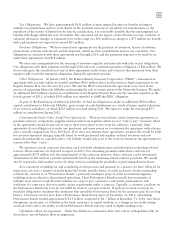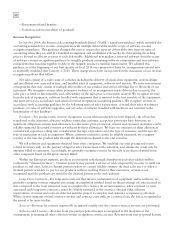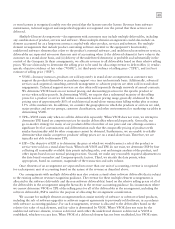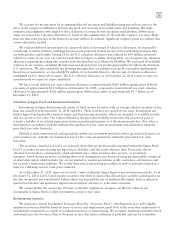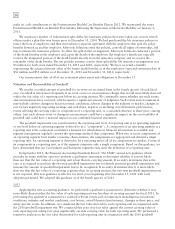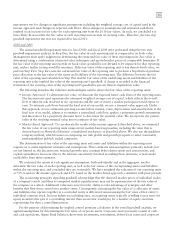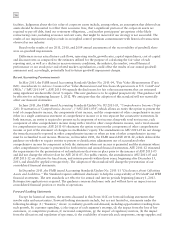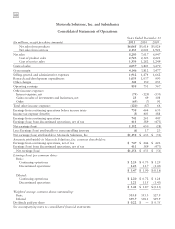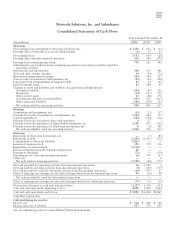Motorola 2011 Annual Report Download - page 60
Download and view the complete annual report
Please find page 60 of the 2011 Motorola annual report below. You can navigate through the pages in the report by either clicking on the pages listed below, or by using the keyword search tool below to find specific information within the annual report.
54
make no cash contributions to the Postretirement Health Care Benefits Plan in 2012. We maintained the entire
Postretirement Health Care Benefits Plan liability following the Separation of Motorola Mobility on January 4,
2011.
We maintain a number of endorsement split-dollar life insurance policies that were taken out on now-retired
officers under a plan that was frozen prior to December 31, 2004. We had purchased the life insurance policies to
insure the lives of employees and then entered into a separate agreement with the employees that split the policy
benefits between us and the employee. Motorola Solutions owns the policies, controls all rights of ownership, and
may terminate the insurance policies. To effect the split-dollar arrangement, Motorola Solutions endorsed a portion
of the death benefits to the employee and, upon the death of the employee, the employee’s beneficiary typically
receives the designated portion of the death benefit directly from the insurance company and we receive the
remainder of the death benefit. The net periodic pension cost for these split-dollar life insurance arrangements was
$5 million for both years ended December 31, 2011 and 2010, respectively. We have recorded a liability
representing the actuarial present value of the future death benefits as of the employees’ expected retirement date of
$56 million and $51 million as of December 31, 2011 and December 31, 2010, respectively.
Our measurement date of all of our retirement plans assets and obligations is December 31.
Valuation and Recoverability of Goodwill
We test the recorded amount of goodwill for recovery on an annual basis in the fourth quarter of each fiscal
year. Goodwill is tested more frequently if an event occurs or circumstances change that would more-likely-than-not
reduce the fair value of a reporting unit below its carrying amount. We continually assess whether any such events
and circumstances have occurred, which requires a significant amount of judgment. Such events and circumstances
may include: adverse changes in macroeconomic conditions, adverse changes in the industry or market, changes in
cost factors negatively impacting earnings and cash flows, negative or declining overall financial performance,
events affecting the carrying value or composition of a reporting unit, or a sustained decrease in share price, among
others. Any such adverse event or change in circumstances could have a significant impact on the recoverability of
goodwill and could have a material impact on our combined financial statements.
The goodwill impairment test is performed at the reporting unit level. A reporting unit is an operating segment
or one level below an operating segment (referred to as a “component”). A component of an operating segment is a
reporting unit if the component constitutes a business for which discrete financial information is available and
segment management regularly reviews the operating results of that component. When two or more components of
an operating segment have similar economic characteristics, the components are aggregated and deemed a single
reporting unit. An operating segment is deemed to be a reporting unit if all of its components are similar, if none of
its components is a reporting unit, or if the segment comprises only a single component. Based on this guidance, we
have determined that our Government and Enterprise segments each meet the definition of a reporting unit.
In September 2011, the Financial Accounting Standards Board (“the FASB”) issued new guidance which
provides an entity with the option to perform a qualitative assessment to determine whether it is more-likely-
than-not that the fair value of a reporting unit is less than its carrying amount. If an entity determines this is the
case, it is required to perform the two-step goodwill impairment test to identify potential goodwill impairment and
measure the amount of goodwill impairment loss to be recognized. If an entity determines that it is more-likely-
than-not that the fair value of a reporting is greater than its carrying amount, the two-step goodwill impairment test
is not required. This new guidance is effective for fiscal years beginning after December 15, 2011 with early
adoption permitted. We adopted this guidance as of the fourth quarter of 2011.
2011
Applying this new accounting guidance, we performed a qualitative assessment to determine whether it was
more-likely-than-not that the fair value of each reporting unit was less than its carrying amount for fiscal 2011. In
performing this qualitative assessment we assessed relevant events and circumstances including macroeconomic
conditions, industry and market conditions, cost factors, overall financial performance, changes in share price, and
entity-specific events. In addition, we considered the fair value derived for each reporting unit in conjunction with
the 2010 goodwill impairment test. We compared this prior year fair value against the current carrying value of
each reporting unit noting fair value significantly exceeds carrying value for both reporting units. We performed a
sensitivity analysis on the fair value determined for each reporting unit in conjunction with the 2010 goodwill



